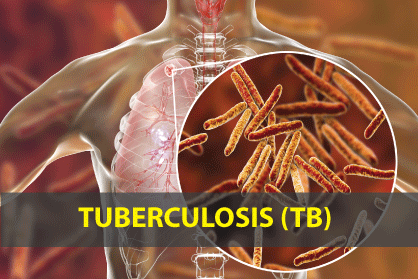Full Form of TB
Full Form of TB
TB - TUBERCULOSIS

TB is an abbreviation of TUBERCULOSIS. It is a transmissible disease caused by germs or bacteria through droplets in the air that generally affects the lungs; nevertheless, it can infect any part of the body such as the brain, the kidneys, or the spine. TB can be deadly, but if they get good treatment, it is preventable and treatable. It takes many years to be cured. A person may grow TB after inhaling Mycobacterium tuberculosis bacteria. When a person comes in close contact with a person who has this type of TB which is communicable and affects the lungs, then that person commonly gets sick. In the past, tuberculosis was called consumption.
Types of Tuberculosis and Symptoms (Tb)
Many people don't experience tuberculosis at the same time. Instead, the infection might go into three types:
- Primary TB infection- this stage is when bacteria go inside a body. Many people never experience any symptoms, but others may encounter fever or pulmonary symptoms. People who have robust immune systems will not evolve any symptoms of infection, except in many people, the bacteria might extend and evolve inactive disease.
- Latent TB infection- the TB bacteria is in the body and never develops symptoms. In this stage, the disease cannot be transmissible, and people don’t experience symptoms. It can only be established by tests but is not active. Nevertheless, a person who has latent TB still needs treatment.
SYMPTOMS- people with this type of infection have no symptoms.
3. Active disease- in this stage, TB bacteria are active and transmissible because of people with weak immune systems. People feel sick and illness is transferable. It is a crucial stage, and treatment should be started straight away to avoid others getting infected.
The risk of inactive TB is more significant in:
· People with weak immune systems.
· People who first evolved the infection over 2-5 years.
· Young children and older people.
- People with HIV.
- People who are on dialysis.
· People who haven’t acquired proper treatment for TB in the past.
SYMPTOMS- people with TB disease might get a cough, fatigue, fever, body aches, chest pain, night sweats, trouble in breathing, and loss of weight. Symptoms increase over time but also can be cured and returned.
CAUSES
Tuberculosis is transmitted through the air droplets, which means it can only be caused by breathing. It happens when a person with active TB coughs, sneezes, spits, or speaks. However, most people with this disease cannot spread the bacteria if they have obtained proper treatment for more than two weeks.
DIAGNOSIS
Diagnosing tuberculosis is a complicated task. Doctors will first ask some questions for the TB test, like- if they have spenttime with a person who has TB or have gone to another country with high TB rates. After this, the doctors will check to swell in the lymph nodes and listen to the lungs.
Two tests for latent TB infection are-
- The skin test is also known as the Mantoux test or purified protein derivative (PPD).
- Blood test
However, Blood tests give more accurate results than skin tests. Even doctors also recommend blood tests.
For Inactive TB disease, some tests include:
- A sputum test is done when mucus comes up while coughing.
- Molecular tests
- Biopsy of lungs, lymph nodes, or any other tissue.
- X-rays of chest
- Bone scans
- Computerized tomography (CT) scan for a better view of the lungs
- Magnetic resonance imaging (MRI) of the brain or spine if these areas have TB infection.
TREATMENT
TB can be treatable with proper medication for eradicating all the bacteria, but in many parts of the world, TB still causes death. The length of treatment varies from person to person. People with latent TB may take nine months for everyday antibiotics and 12 weeks for once a week, or it may vary. Treatment for active TB patients may need an amalgamation of several drugs for 6-9 months.
It is necessary to finish the entire course. If a person stops their medication in between, then leftover bacteria can keep on growing and become resistant to antibiotics. Then it will become more challenging to treat.
Active TB is transmissible so that DOT (directly observed therapy) is hired to check whether a patient is taking their medicine and write on documents that medicines have been taken.
PREVENTION
To prevent tuberculosis, a person should keep their immune system strong and avoid people with active TB. A person should not delay treatment of latent TB before it gets converted into active TB.
Some other steps to prevent the spread of TB are:
- Enhance ventilation in indoor spaces so there are fewer bacteria in the air
- Wearing a mask, covering the mouth
- Using germicidal UV lamps to kill airborne bacteria
- Hiring DOT for patients to check if they are taking proper medication for TB.
RISK of TB
People who have weak immune systems are likely to get infected with TB. People who have HIV or AIDS have a higher risk of evolving TB. Treatment of TB can be brutal in a person with HIV. Some other risk factors for TB are:
- Smoking (tobacco use or secondhand smoke increase the risk)
- Kidney disease
- Diabetes
- Poverty
- Cancer
- Air pollution
- Organ transplant
- Low body weight
- Silicosis
If TB spreads all over the body, the infection can generate trouble with the cardiovascular system and metabolic function, among other issues. It can also effectuate sepsis which is a hazardous form of infection.
Therefore, people who have such kinds of symptoms should consult a doctor before it worsens or evolves inside the body.